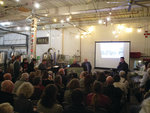Imagine, in just a decade, Cranston’s electricity needs being met entirely through renewable energy sources, including solar and wind.
That is the vision the Rhode Island Rhode Island …
This item is available in full to subscribers.
We have recently launched a new and improved website. To continue reading, you will need to either log into your subscriber account, or purchase a new subscription.
If you are a current print subscriber, you can set up a free website account by clicking here.
Otherwise, click here to view your options for subscribing.
Please log in to continue |
|


Imagine, in just a decade, Cranston’s electricity needs being met entirely through renewable energy sources, including solar and wind.
That is the vision the Rhode Island Rhode Island Progressive Democrats of America laid out during an event last week at Buttonwoods Brewery on Wellington Avenue – and those behind the plan say it is achievable, albeit still in its early stages.
“The world needs a leader, and Rhode Island can be that leader by turning the birthplace of the Industrial Revolution into the wellspring of a new green energy revolution,” said Will Gregersen, environmental coordinator for the Rhode Island Progressive Democrats of America.
He added: “There are a lot of questions we have to answer to reach our goals, but before we can start work on any of those, we need to answer this question first – is it possible for a Rhode Island city to generate 100 percent of its energy needs? The answer is yes.”
During the Buttonwoods Brewery event – which drew a stand-room crowd to the venue’s taproom – Joshua May and Brandon Boucher of Ocean State Community Energy outlined the contours of their “blueprint” for Cranston’s renewable energy future.
The full 43-page plan was released online Friday, and can be found at riprogressivedems.com.
May said Ocean State Community Energy is a joint venture of ReVenture Investments and 4E Energy Consulting. He said the entity has teams in Rhode Island, Massachusetts and Canada, and has prepared similar presentations and proposals for locations across Canada as well as in the Northeast in Midwest.
“This is by far the most ambitious and exciting we’ve worked on to date,” he said of the Cranston blueprint.
Work on the plan began approximately 12 weeks ago when May and Boucher were approached by Gregerson and Nate Carpenter, state coordinator of the Rhode Island Progressive Democrats of America. The development of the plan has been funded through donors, who according to a list provided at the event include state Rep. Arthur Handy (D-Dist. 18, Cranston), Cranston Citywide Councilman Steve Stycos and members of the Cranston Action Network.
Solar energy development specifically has been a contentious issue in the city in recent years, and a moratorium is currently in place for the kind of large, commercial-scale developments that have been built or proposed at several undeveloped, residentially zoned areas in Western Cranston.
Critics say such projects have negative environmental impacts – especially through the clearing of trees – and alter the character of neighborhoods. The City Council’s Ordinance Committee held a special meeting Tuesday night to consider proposed new solar regulations.
May and Boucher said at the outset of the Cranston blueprint’s development, one restriction was clear – the use of green space on the western side of the city was off limits. That, they said, actually provides some of the project’s appeal and makes it a potential model.
“Cranston was chosen because … it we could do it in Cranston, we could do it anywhere. And that wasn’t from a political standpoint,” May said. “It was from density of population, lack of green space and your typical acreage that you would use for renewable energy.”
More broadly, Carpenter said his organization’s goal is “to transform Rhode Island into the first state that is run exclusively on renewable energy and to do it in a way that brings prosperity back to every person that lives here.” He and Gregersen said pursuing a renewable energy future will help combat climate change while providing a number of benefits for the state, including job creation, economic growth and lower energy costs.
The Cranston blueprint outlines a number of components involved in the 100-percent renewable energy goal – solar, wind, a decentralized micro-grid, energy storage and improved energy efficiency.
Specifically, it involves the installation of solar energy systems at residential, commercial and municipally owned sites throughout the city; the installation of small vertical wind turbines on commercial and residential sites; the creation of a “decentralized micro-grid that reduces inefficiency and energy waste, lowers outages, lowers maintenance costs, and distributes energy from any location to anywhere it’s needed in the city”; the development of energy storage capabilities; and work to increase energy efficiency through accelerated retrofits for LED lighting, insulation and updated HVAC systems across the city’s residential, commercial and municipal buildings.
The “smart micro-grid,” May and Boucher said, is a major component of the blueprint and its goal. May cited the example of Vancouver, which saw its energy efficiency jump from roughly 40 percent to more than 80 percent through the upgrade to a smart grid.
Boucher said the smart micro-grid “optimizes the entire system” and fosters “resiliency” by utilizing storage to best provide for peak usage and protect against outages resulting from extreme weather events. It relies on communication among various points within the system through a central control.
“It is constantly talking to all of the smart pieces, so every commercial, every single municipal building, every single residential, will have a smart chip in it … All of this can be accomplished with the optimization and the scalability of a smart grid, to where the entire town, the entire community, everybody benefits from generating, transporting, storing and actually distributing their own power that’s made right down the street,” he said.
May said the blueprint is based on an estimate of 198 megawatts used across the Cranston in 2018 – a figure he was reached using the best available data.
Boucher and May acknowledged that many aspects of the blueprint will require further development. A cost estimate for implementing the plan, for example, was not provided – something Boucher said was done intentionally.
“If we give you a number now, it will change two weeks down the road when we get more data,” he said. “So if we throw out an astronomical number, it turns off people right away when we know we’re going to have a much better understanding once we get all the players talking to each other.”
During the coming months, May said, the blueprint’s backers will be working with companies and consultants to developer a clearer picture of what new renewable energy systems could look like across the city. Thus far, those include Re-Wind, Electrious and Solar Site Design.
He said the Cranston project has generated significant interest, which could yield economic dividends locally.
“We’ve never seen this type of excitement and buy-in … They’re coming to the table just because of how exciting this project is and what it could mean for the state and the country,” he said.
May said the work ahead will also involve talks with municipal leaders and pursuing other partnerships that will be essential to the effort’s success.
“This is going to have to be a public-private partnership,” he said. “There’s no way we can ask the municipalities and the state to do this all on their own. It’s going to require private commercial and residential cooperation to be able to hit the goal.”
Comments
No comments on this item Please log in to comment by clicking here